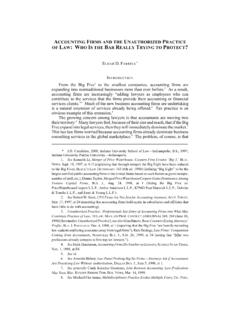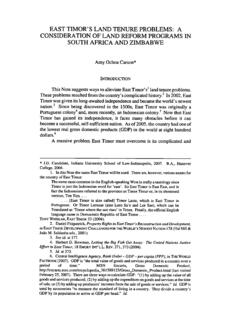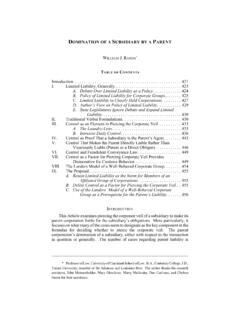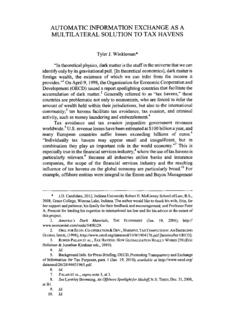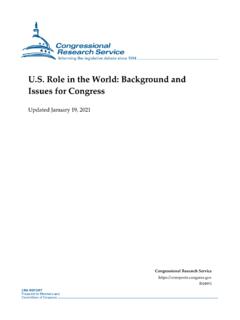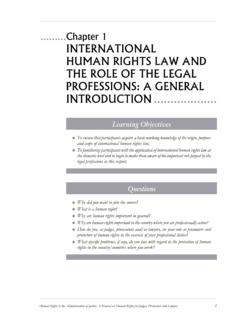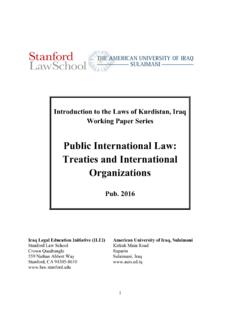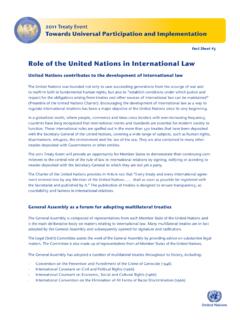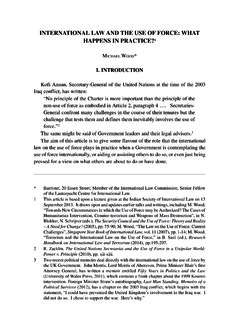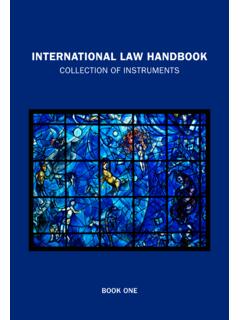Transcription of Right to Self-Defence in National and International Law ...
1 "I KNOW NOT WITH WHAT WEAPONS WORLD WAR Im WILL BE FOUGHT, BUTWORLD WAR IV WILL BE FOUGHT WITH SUCKS AND STONES."EINSTEIN1 THE Right TO Self-Defence IN National ANDINTERNATIONAL LAW: the role OF THEIMMINENCE REQUIREMENTO nder Bakircioglu*This article explores the doctrine of Self-Defence within the context of thechallenges directed at the imminence requirement, from the perspective of bothnational and International law. The article will attempt to illustrate that therequirement of imminence underlines the political character of the self-defencedoctrine wherein private force may only be resorted to in the absence ofinstitutional protection.
2 This study will argue that the imminence rule can notmerely be regarded as a "proxy" for establishing necessity; rather, the elementsof imminence, necessity, and proportionality are inextricably connected toensure that defensive force is only resorted to when National or internationalauthorities are not in a position to prevent an illegal aggression, and that thedefensive lethal force is not September 11 attacks aroused controversy as to whether anticipatoryor pre-emptive self-defence2 is allowed under customary International law, andif so, under what circumstances.
3 Following the devastating attacks on NewYork and Washington, the 2002 National Security Strategy (NSS) made it clearthat the United States would act unilaterally to protect its security against"emerging threats before they are fully formed."3 This approach signified aradical departure from the collective security system by the sole existing superpower. Indeed, while the Right to National Self-Defence has been recognized asan inherent Right of states since the very emergence of International law,* Onder Bakircioglu, Lecturer in Law, Queen's University Belfast.
4 The author isindebted to Professor Caroline Fennell for her constructive comments on earlier drafts of OFFICIAL REPORT OF THE PROCEEDINGS OF THE TWENTY-FOURTH REPUBLICANNATIONAL CONVENTION 165 (1948);.CAMERON HUNT, PAX UNrrA 96 (2006).2. In this study these terms will be used interchangeably as a distinct category frompreventive David Adler, George Bush and the Abuse of History: The Constitution andPresidential Power in Foreign Affairs, 12 UCLA J. INT'L L. & FOREIGN AFF. 75, 121 (2007).IND. INT'L & COMP. L. to the United Nations Charter,4 states are prohibited from resorting todefensive force unless the threat is actual or imminent and the Security Councilis unable to contain the Bush Administration, however, argues that modem warfare andrecent innovations in military technology, which may also be employed by non-state actors engaged in terrorist activities, changed the whole calculus of Warfare warfare is now much more devastating and can occur withless warning.
5 Which gives considerable advantage over an opponent if allowedto strike first. It would thus be unreasonable and unrealistic to employ theorthodox principles governing the Right to Self-Defence , namely to await theoccurrence or the threat of an imminent "armed attack" to use defensive threatened by such weapons may not have the time to appeal to theUnited Nations and may be compelled to use pre-emptive force to prevent anopponent from gaining an overwhelming military , the controversy over the need to modify the Right to Self-Defence is not exclusive to International law.
6 The equivalent of such a debatehas also been conducted in domestic criminal law particularly within thecontext of the battered woman's Self-Defence claims raised in non-confrontational settings. On behalf of the "battered woman," some scholars, inparticular feminist commentators, have challenged the non-responsiveness ofthe Self-Defence doctrine in domestic violence cases. These scholars, as shownbelow, have questioned the patriarchal construction of the self-defencediscourse and opposed the rigid application of the temporal (imminence)requirement in cases where victims of domestic abuse employ fatal forceagainst their abusers when the anticipated threat is not imminent.
7 According tothis school of thought, the requirement of imminence is merely a "translator" or"proxy" for the concept of necessity, which should, therefore, be discardedfrom the traditional contours of the Self-Defence article examines the bounds of Self-Defence through the domesticanalogy, where the imminence rule is analyzed within the context of batteredwomen's and the Bush Administration's claims. An analogy is drawn with thedomestic context not only because there exist considerable similarities betweenthe rights and duties of National and International persons in the theory ofaggression and Self-Defence , but also because National law has a richjurisprudence on Self-Defence with significant lessons and insight to offer to theanalogous debate in International law.
8 Admittedly, arguments produced at thedomestic and International level were meant to address different scenarios, yet4. Charter art. THE WHITE HOUSE, THE National SECURITY STRATEGY OF THE UNITED STATES OFAMERICA 15 (2002), available at [hereinafter THEWHITE HOUSE].6. See Onder Bakircioglu, The Contours of the Right to Self-Defence : Is theRequirement of Imminence Merely a Translator for the Concept of Necessity? 72 J. CRIM. , 156-59 (2008).[Vol. 19:12009] IMMINENCE AND THE Right TO NAT'L AND INT'L Self-Defence 3the striking closeness of the logic and reasoning behind the attempt to alter thedoctrine of Self-Defence gave the present author the impetus to study thedoctrine of Self-Defence from a wider and comparative perspective.
9 It must benoted that this study does not blindly deny the relevant differences of interstateand interpersonal relations. A comparative analysis of the Self-Defence doctrinemust naturally take such differences into article will attempt to demonstrate that the requirement ofimminence underlines the political character of the Self-Defence doctrinewherein private force may only be resorted to in the absence of institutionalprotection. The study will further show that the imminence rule can not merelybe regarded as a "proxy" for establishing necessity.
10 Rather the elements ofimminence, necessity and proportionality are inextricably connected to ensurethat private force is only resorted to when National or International authoritiesare not in a position to prevent an illegal aggression, and that the defensivelethal force is not invoked for ulterior Self-Defence AND THE DOMESTIC ANALOGYThe relationship between National and International law has long been thesubject of controversy among legal scholars. There are two essential theories,along with a number of various interpretations, explaining the nexus betweeninternational and domestic law.
